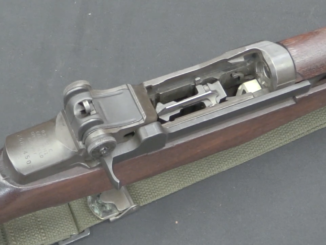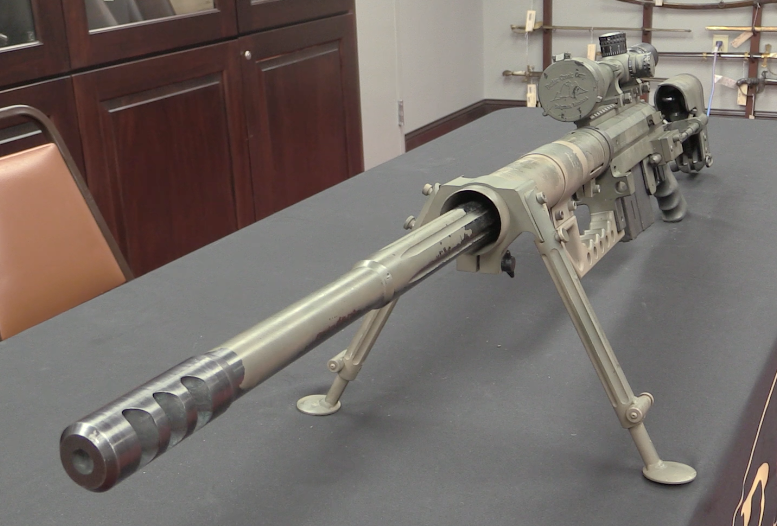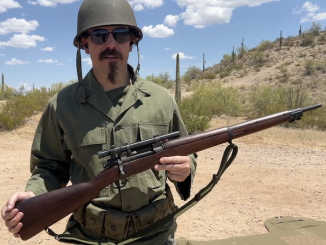The Wesson & Leavitt is one of the scarcest revolving rifles made in the US, with no more than 50 made (some sources say only 16). The reason for this is that the Dragoon revolver which Wesson & Leavitt based the rifle on was found to be in violation of several Colt patents. Most importantly, when the Wesson & Leavitt Dragoon was introduced in 1850, Colt had a patent on the feature of having the cylinder index automatically when the hammer is cocked. They filed suit against Wesson & Leavitt, and won the case in 1851, before very many of the revolvers had been made.
Related Articles

Conversion
Navy 7.62mm NATO Conversion M1 Garand – Mk2 Mod1
When the M14 rifle was developed to replace the M1 Garand, is was met with some uncertainty by the US Navy. The Navy had a lot of things to spend money on, and not a […]

Bolt Action Rifles
RIA: CheyTec M200 Intervention
The CheyTac M200 Intervention is a massive precision rifle chambered for the .408 CheyTac cartridge (although it can also be had in .375 CheyTac). It uses an action made by EDM Arms, and is capable […]

Bolt Action Rifles
Remington M1903A4 Sniper at the Range
Today we are taking the Remington M1903A4 out to the range for some shooting. This was the standard US sniper rifle during World War Two, and I’m curious to see how one actually handles…

If I was selling revolving rifles, each one would come with gauntlet style gloves made of thick cow hide; a pair so the shooter could shoot right or left handed.
I like the looks of that rotating collar with a pin, instead of the usual cylinder hand.
Have replica Remington, Colt, and Le Mat revolvers, and load powder and ball with the cylinder in a modified wine bottle cork press.
Even that wouldn’t help with a “turret” type rifle.
Most people in our area of interest have heard of the Porter turret rifle and pistol;
http://www.19thcenturyweapons.com/909/porter.html
It wasn’t too popular because a multiple discharge would likely take your head off. In fact, Sam Colt spread a rumor that this was exactly what had happened to the inventor, who was supposedly killed in the process.
Actually, P. W. Porter was very much alive. But after he failed to sell his “turret guns” mainly due to people’s very real concerns about flashovers and chainfires, he spent the rest of his life making and selling more conventional arms.
Colt’s tall tale still shows up in the literature as fact on occasion, right up there with Fred Merwin of Merwin & Hulburt being killed by the Kiowa, thus causing the demise of the company. Actually, the company was in receivership before that, but Merwin did in fact die “out west”; he had a heart attack and died in his sleep in his hotel room in Denver, CO.
cheers
eon
The thing that caught my eye was the curved front of the cylinder and matching curve on the barrel.
Looking at Daniel Leavitt’s original patent: http://www.google.com/patents/US182
The claim was not for a revolver mechanism, but for that curved surface at the front of the cylinder which is claimed to prevent the accidental discharge of neighboring chambers.
While that would prevent chain-firing, I don’t think local blacksmiths and gunsmiths could reproduce the curved frame area too well. That would be the only possible weakness–lack of readily available tooling for that particular feature… Or am I wrong?
I would rather take a Podewils or a Dreyse over any percussion revolver-rifle, if only to keep loading a simple matter.
No, you’re not. Something like that can only really work if you have the ability to machine down to ten-thousandths of an inch to reduce the gap to the absolute minimum.
Machinists in the mid-19th Century were generally working to thirty-seconds of an inch, sixty-fourths if they had really precise equipment. (In the 1600s and 1700s, they were doing well if they were working to sixteenths of an inch tolerances.)
The “tech level” just wasn’t up to making this setup work.
BTW, while I agree that the Dreyse and Podewil were superior to this setup, I’d like to point out that the Sharps single-shot breechloader was available as early as 1851. It was a bit more durable.
😉
cheers
eon
Kind of a shame you weren’t able to show us the lockwork; it sounds like the rotation mechanism would be interesting to see the internals of: http://americansocietyofarmscollectors.org/wp-content/uploads/2013/05/B037_Jones.pdf
Just ran across what my be the only Rufus Porter revolving rifle in the world at the Rufus Porter Museum in Bridgeton, Maine. Porter’s revolving rifle patent (1826) predated Colt’s. Colt bought the rifle and the rights to avoid any patent problems. The Rifle is on display until October 12th, at which point it goes back into the vaults at the Wadsworth Antheneum in Hartford, CT, where it obtained as a gift from the Colt family. Rufus Porter is also notable for being the first editor of Scientific American magazine.
There are some interesting comments about tolerance.
As a tool and instrument maker, I have a bit of a chip to add to the knowledge pool.
Tolerance can be specified in two ways.
By fit in comparison to the parts around it
And
By measurement, basically comparing the part to a known master.
Tolerances by measurement where not up to snuff, meaning most guns, and mechanical equipment could not have interchangeable parts, or would have to rely on tapers ect to fit together.
However
Tolerance by fit has been able to hit microscopic levels for well.. the techniques still used today predate written history. No less iron. Some tools found in the stone age are starkly similar to the fitment tools used today
Basically by getting either soot or oily dye on one part, rubbing it against its mating part and looking where the soot or dye rubs off you now know the high spots, you file them down, and then wash and repeat, by the time it looks mostly even you have a fitment that is within about .00025 give or take, this is because files can take off an exceptionally small amount then they would (and we still do) take very fine powdered grinding media and lap the two parts together by rubbing them intentionally in the direction they would fit more or less, how they would work together.
Now, that was labour intensive even in the days when labour was cheap.
So, yes it could work with the tech of the day. But that rounded design might bankrupt a company unless they had some kind of semi automated lapping rig.
Buuuut, there are surviving examples of automated lapping rigs, used exclusively for gun smithing from the 1700’s and 1800’s some of these could easily make this design work (although, nothing mated would work with other rifles)
Buuut to complicated it all more, these tended to be national and company secrets for making better weapons of course, but top secret stuff. Really this was the stuff you wanted to keep out of anyone else’s hands
And to complicate it more, some companies had the ability to make only flat surfaces mate, others had the tech to only mate together hole locations, or only could make curved surfaces, or very accurate bores ect ect.
So, this could be a case of the gunsmith utilizing what tools they had to make the best they could, without realizing, they alone had the tools to make that shape work.
And that was surprisingly common in the 1800’s there are a lot of patents filed for this reason, and I find it phenomenal, and fascinating to look into, and I think that makes this particular example even cooler.